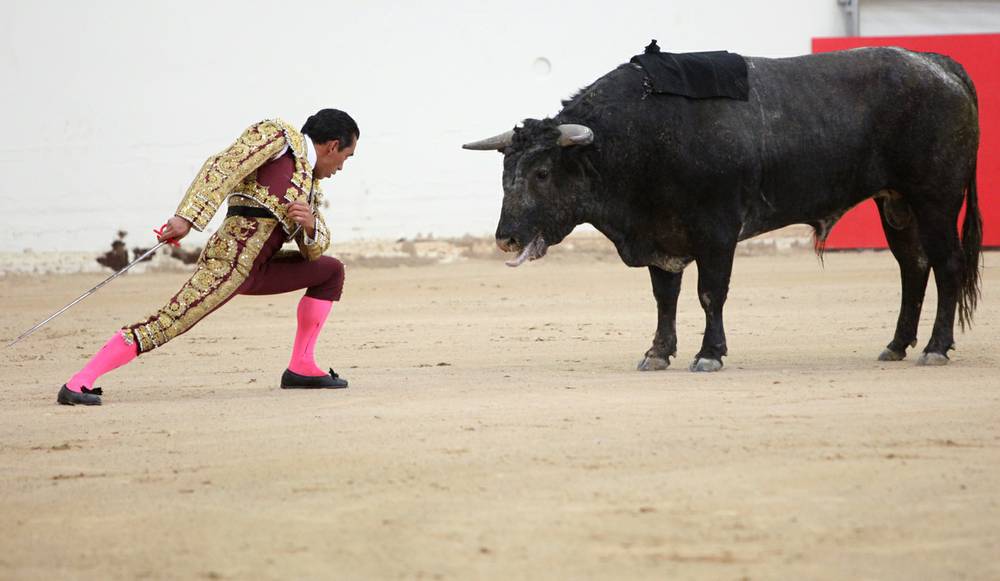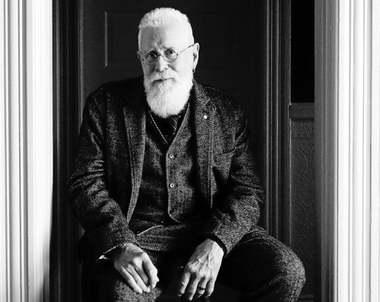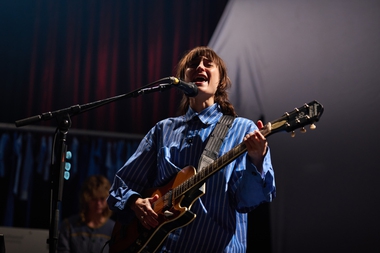Three feet away are a thousand pounds of muscle, horn and frustration, but you wouldn’t know it by the look on El Zotoluco’s face. The smile stretched across it is a showman’s, wide and confident, projected toward the sparse crowd inside the South Point Equestrian Center. His arm is raised in a triumphant pose. Never mind that a massive bull ironically named Amigo is drooling directly behind him, untethered, uninjured and entirely unrestrained. El Zotoluco looks happy.
You wouldn’t turn your back on a bull like that because it’s dangerous, because bulls are aggressive and prone to gore people who get in their way, and because that much angry flesh is enough to scare anyone into hiding behind something strong and hoping for the best. But you are not Eulalio “El Zotoluco” Lopez. When the 41-year-old matador noticed the first of two bulls he would fight during the September 14 bloodless bullfights at the South Point was getting a little unenthused, the slight, soft-spoken Mexican stood in front of the animal and chided it a bit.
“Vamos!” he called, a challenge in his voice. Then, with a twitch of the cape, he beckoned the bull forward.
“I’ve been a matador for 23 years,” Lopez said as he prepared to enter the ring for the first Las Vegas based bullfights in more than 40 years. “I’ve been lucky enough to fight in virtually every country where there are bullfights – of course my country, Mexico, Spain, France, parts of South America – Venezuela, Colombia, Ecuador. I’ve had a beautiful career, a long one. I’ve fought in almost 1,000 bullfights.”
The fights on Monday marked the inaugural day of the Fiestas Patrias celebrating Mexican Independence Day, which will continue September 27-30 with more bullfighting. The event brought three matadors to face bulls – Lopez, Alfredo “El Conde” Ríos and Julio “El Cordobés Hijo” Benítez – but while el matador literally translates to “the killer,” the men trained in the art of execution would kill nothing while on American soil.
Produced by Mexican bullfighting impresario Pedro Haces Barba of Don Bull Productions, the fights were everything you would see inside a plaza de toros in Mexico or Spain except the blood. The matadors were imported for the event and paid handsomely for their presence, in Lopez’s case $600,000. They still donned the elaborate traje de luces, the ornate uniform adorned with gold brocade. The bulls still charged into the ring snorting and circling. And the crowd, mostly Mexican judging by the many lips mouthing the lyrics to the Mexican national anthem during the pre-fight ceremony, still yelled “Olé!” when the bullfighters executed an especially impressive pass or dropped to their knees in front of the bull to add drama to the innately dramatic spectacle.
Calendar
- Bloodless Bullfighting
- Sept. 27-30, $60-$550
- South Point Equestrian and Events Center
- Don Bull Productions
- From the Archives
- Bloodless bullfighting: A tradition evolved or just plain bull? (5/29/09)
In fact, while not a single drop of blood was shed during the event, the Las Vegas fights were more dangerous than the matadors’ normal day of work. Without injuring the massive bulls, which are bred for their strength and bravery, the animals are less easy to approach. They’re less tired, less likely to follow the cape and less likely to avoid plunging their horns into the bullfighters’ unprotected stomachs. Fighting the bulls at full power is frightening even for a veteran like Lopez. But the fear, he explained, is part of the fun.
“You always suffer. The fear is always present,” Lopez said. “Bullfighters, we always feel fear. It’s part of the show. Knowing the responsibility of risking your life isn’t easy, but I like it. I do it with pleasure.”
As the climax of the performance approached, Lopez steered the bull and its intimidating horns closer and closer to his narrow body. Then the matador did something he’s not accustomed to. Instead of driving a lengthy sword into the animal’s withers – rupturing its heart and causing it to immediately drop dead on the arena floor – he pulled from behind the cape, a decorated banderilla or staff. The matador arched over the bull’s head and brought the banderilla’s Velcro tip down onto a Velcro pad waiting on the bull’s back.
A cheer rose from the crowd, “Olé!”
El Zotoluco strutted away from the animal. He saluted the audience and his fans, gesturing upwards at the stands where they applauded him. A band of mariachis picked up its lively tune, now a celebration of the bullfighter’s bravery and success in the ring.
The smile was back on Zotoluco’s face, but the bull just stood there, its tongue lolling and the new accessory dangling from its back. Only the animal seemed not to realize what had happened, that it had lost the match.








Previous Discussion: